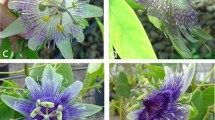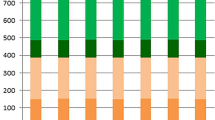Abstract
Intergeneric hybridizations were produced between Elachanthemum intricatum (Franch.) Ling et Ling and Opisthopappus taihangensis (Y. Ling) C. Shih without emasculation. About 12 and 16 % seed settings were obtained in reciprocal hybridizations. 17 seedlings germinated from 183 seeds from Elachanthemum intricatum (Franch.) Ling et Ling as female parent and 13 seedlings germinated from 109 seeds of Opisthopappus taihangensis (Y. Ling) C. Shih as female parent. 14 and 8 plants survived to maturity respectively. Only one progeny from Elachanthemum intricatum (Franch.) Ling et Ling in these hybridizations was found to be a true hybrid from the morphological characteristics and sequences of nrDNA ITS. The leaves of this new hybrid show some conspicuous intermediate features. The new hybrid has 5–8 mini ray female florets in the outer row of capitula. It is perennial just like its paternal parent (Opisthopappus) in contrast to its biennial maternal parent (Elachanthemum).





Similar content being viewed by others
Abbreviations
- OT:
-
Opisthopappus taihangensis (Y. Ling) C. Shih
- EI :
-
Elachanthemum intricatum (Franch.) Ling et Ling
- EI × OT :
-
Elachanthemum intricatum (Franch.) Ling et Ling × Opisthopappus taihangensis (Y. Ling) C. Shih
- AF :
-
Ajania fastigiata (C. Winkler) Poljakov
- Crossostephium :
-
Crossostephium chinense (L.) Makino
- AS :
-
Artemisia sericea (Besser) Weber ex Stechmann
- AV :
-
Ajania variifolia (C. C. Chang) Tzvelev
References
Abd El-Twab MH, Kondo K (2001a) Molecular cytogenetic identification of the parental genomes in the intergeneric hybrid between Leucanthemella linearis and Nipponanthemum nipponicum during meiosis and mitosis. Caryologia 54:109–114
Abd El-Twab MH, Kondo K (2001b) Genome territories of Dendranthema horaimontana in mitotic nuclei of F1 hybrid between Dendranthema horaimontana and Tanacetum parthenium. Chromosom Sci 5:63–71
Abd El-Twab MH, Kondo K (2006) Fluorescence in situ hybridization and genomic in situ hybridization to identify the parental genomes in the intergeneric hybrid between Chrysanthemum japonicum and Nipponanthemum nipponicum. Chromosom Bot 1:7–11
Abd El-Twab MH, Kondo K (2007a) FISH physical mapping of 5 s rDNA and telomere sequence repeats identified a peculiar chromosome mapping and mutation in Leuchanthemella linearis and Nipponanthemum nipponicum in Chrysanthemum sensu lato. Chromosom Bot 2:11–17
Abd El-Twab MH, Kondo K (2007b) Identification of parental chromosomes, intra-chromosomal changes and relationship of the artificial intergeneric hybrid between Chrysanthemum horaimontanum and Tanacetum vulgare by single color and simultaneous bicolor of FISH and GISH. Chromosom Bot 2:113–119
Alvarez I, Wendel JF (2003) Ribosomal ITS sequences and plant phylogenetic inference. Mol Phylogenet Evolut 29:417–434
Anderson N (2006) Chrysanthemum, Chrysanthemum x grandiflora Tzvelv. In: Anderson N (ed) Flower breeding and genetics issues, challenges and opportunities for the 21st century. Springer, pp 389–437
Bailey CD, Carr TG, Harris SA, Hughes CF (2003) Characterization of angiosperm nrDNA polymorphism, paralogy and pseudogenes. Mol Phylogenet Evolut 29:435–455
Bremer K, Humphries CJ (1993) Generic monograph of the Asteraceae-Anthemideae. Bull Nat Hist Mus Lond (Bot) 23:71–177
Broholm SK, Ta¨htiharju S, Laitinen RAE, Albert VA, Teeri TH, Elomaa PA (2008) TCP domain transcription factor controls flower type specification along the radial axis of the Gerbera (Asteraceae) inflorescence. Proc Natl Acad Sci USA 105:9117–9122
Chapman MA, Leebens-Mack JH, Burke JM (2008) Positive selection and expression divergence following gene duplication in the Sunflower CYCLOIDEA gene family. Mol Biol Evolut 25:1260–1273
Deng Y, Chen S, Lu A, Chen F, Jang F, Guan Z, Teng N (2010) Production and characterisation of the intergeneric hybrids between Chrysanthemum morifolium and Artemisia vulgaris exhibiting enhanced resistance to Chrysanthemum aphid (Macrosinhoniella sanbourni). Planta 231:693–703
Gemeinholzer B, Oberprieler C, Bachmann K (2006) Using GenBank data for plant identification: possibilities and limitations using the ITS1 of Asteraceae species belonging to the tribes Lactuceae and Anthemideae. Taxon 55:173–187
Jong J, de Rademaker W (1989) Interspecific hybrids between two chrysanthemum species. HortScience 24:370–372
Kim M, Cui M, Cubas P, Gillies A, Lee K, Chapman MA, Abbott RJ, Coen E (2008) Regulatory genes control a key morphological and ecological trait transferred between species. Science 14:1116–1119
Kondo K, Tanaka R, Hizume M, Kokubugata G, Hong D, Ge S, Yang Q (1998) Cytogenetic studies on wild Chrysanthemum sensu lato in China VI. Karyomophological characters of five species of Ajania and each one species of Brachanthemum, Dendranthema, Elachanthemum, Phaeostigma and Tanacetum in Highlands of Gansu, Qinghai and Sichuan Province. J Jpn Bot 73:128–136
Kondo K, Abd El-Twab MH, Tanaka R (1999) Fluorescence in situ hybridization identifies reciprocal translocation of somatic chromosomes and origin of extra chromosome by an artificial, intergeneric hybrid between Chrysanthemum japonica × Tanacetum vulgare. Chromosom Sci 3:15–19
Kondo K, Abd EI-Twab MH, Idesawa R, Kimura S, Tanaka R (2003) Genome plylogenetics in Chrysanthemum Sensu lato. In: Sharma AK, Sharma A (eds) Plant genome Biodiversitv and Evolution, vol 1, Part A, pp 117–200
Les DH, Moody ML, Doran AS, Phillips WE (2004) A genetically confirmed intersubgeneric hybrid in Nymphaea L. (Nymphaeceae Salisb.). HortScience 39:219–222
Li J, Teng N, Chen F, Chen S, Sun C, Fang W (2009) Reproductive characteristics of Opisthopappus taihangensis (Y. Ling) C. Shih, an endangered Asteraceae species endemic to China. Sci Hortic 121:474–479
Ling R, Shih Z (1983) Anthemideae, Flora Republicae Popularis Sinicae, vol 76 (1). Science Press, Beijing, pp 73–74, 97–98
Oberprieler C, Himmelreich S, Källersjö M, Vallès J, Watson LE, Vogt R (2009) Anthemideae. In: Funk VA, Susanna A, Stuessy TF, Bayer RJ (eds) Systematics, evolution, and biogeography of Compositae. IAPT, Vienna, Austria, pp 631–666
Ohtsuka H, Inaba Z (2008) Intergeneric hybridization of marguerite (Argyranthemum frutescens) with annual chrysanthemum (Glebionis carinatum) and crown daisy (G. coronaria) using ovule culture. Plant Biotechnol 25:535–539
Sang T, Carwford D, Stuessy T (1995) Documentation of reticulate evolution in peonies (Paeonia) using internal transcribed spacer sequences of nuclear ribosomal DNA: Implications for biogeography and concerted evolution. Proc Natl Acad Sci USA 92:6813–6817
Shi Z, Chen YL, Chen YS, Lin YR, Liu SW, Ge XJ, Gao TG, Zhu SX, Liu Y, Yang QE, Humphries CJ, Raab-Strauße von E, Gilbert MG, Nordenstam B, Kilian N, Brouillet L, Illarionova ID, Hind DJN, Jeffrey C, Bayer RJ, Kirschner J, Greuter W, Anderberg AA, Semple JC, Štěpánek J, Freire SE, Martins L, Koyama H, Kawahara T, Vincent L, Sukhorukov AP, Mavrodiev EV, Gottschlich G. (2011) Asteraceae (Compositae). In: Zhengyi Wu, Raven PH, Hong D (eds) Flora of China 20–21, pp. 1–894. Science Press, Beijing & Missouri Botanical Garden Press, St Louis
Shibata M, Kawata J, Amano M, Kameno T, Yamagishi M, Toyoda T, Yamaguchi T, Okimura M, Uda M (1988) Breeding process and characteristics of Moonlight an interspecific hybrid between Chrysanthemum morifolium and C. pacificum. Bull. Nat. Res Inst Veg Ornam Plants Tea Ser A 2:257–277
Swofford DL (2003) PAUP*: phylogenetic analysis using parsimony (*and other methods), version 4. Sinauer Assoc, Sunderland
Tanaka R, Shimotomai N (1961) Cytogenetic studies on the F1 hybrid of Chrysanthemum lineare × Ch. Nipponicum. Zeitschrift fűr Vererbungslehre 92:190–196
Tang F, Chen F, Chen S, Teng N, Fang W (2009) Intergeneric hybridization and relationship of genera within the tribe Anthemideae Cass. (Chrysanthemum crassum (Kitam.) Kitam. x Crossostephium chinense (L.) Makino). Euphytica 169:133–140
Tang F, Chen S, Chen F, Fang W (2011) Distant hybridization between Chrysanthemum and the intergeneric hybrids of Dendranthema and allied genera. Acta Hortic Sinica 38(1):101–107
Tatarenko E, Kondo K, Smirnov SV, Kucev M, Yang Q, Hong D, Ge S, Zhang D, Zhou S, Damdinsuren O, Abd El-Twab MH, Hizume M, Cao R, Vallès J, Motohashi T, Masuda Y (2011) Chromosome relationships among the Chrysanthemum fruticulosum complex. Chromosom Bot 6(3):61–66
Thompson JD, Gibson TJ, Plewniak F, Jeanmougin F, Higgins DG (2007) The ClustalX windows interface: flexible strategies formultiple sequence alignment aided by quality analysis tools. Nucl Acids Res 24:4876–4882
White TJ, Bruns T, Lee S, Taylor J (1990) Amplification and direct sequencing of fungal ribosomal RNA genes for phylogenetics. In: Innis M, Gelfand D, Snisky J, White T (eds) PCR Protocols. A guide to methods and applications. Academic Press, San Diego, pp 315–322
Yang D, Hu X, Liu Z, Zhao HE (2010) Intergeneric hybridizations between Opisthopappus taihangensis and Chrysanthemum lavandulifolium. Sci Hortic 125:718–723
Zhao HE, Liu Z, Hu X, Yin J, Li W, Rao G, Zhang X, Huang C, Anderson N, Zhang Q, Chen J (2009) Chrysanthemum genetic resources and related genera of Chrysanthemum collected in China. Genet Resour Crop Evol 56:937–946
Zhao HB, Chen F, Chen S, Wu G, Guo W (2010) Molecular phylogeny of Chrysanthemum, Ajania and its allies (Anthemideae, Asteraceae) as inferred from nuclear ribosomal ITS and chloroplast trnL-F IGS sequences. Plant Syst Evol 284:153–169
Zhu ZY, Liang C, Wang W, Liu Z (2003) A new species of Elachanthemum and discussion on the classification and evolution of the genus. Bull Bot Res 23:147–156
Acknowledgments
We appreciated the revising of Jaap Spaargaren and anonymous reviewers on an earlier version of this paper. This research was mainly supported by NSF of Beijing (6022014), NSF of China (30271103), NSF of China (30970207), the main Project of Beijing Municipal Bureau of Landscape and Forestry (YlHH2008002), National Forestry Public Welfare Special Research Foundation (200704043), The National 11th Five-Year Key Technology R&D Program (2006BAD01A18), The National High Technology Research and Development Program(“863” Program) of China (2008AA10Z156).
Author information
Authors and Affiliations
Corresponding author
Additional information
Y. Zheng and J. Shen contributed equally to this work.
Rights and permissions
About this article
Cite this article
Zheng, Y., Shen, J., An, Y.M. et al. Intergeneric hybridization between Elachanthemum intricatum (Franch.) Ling et Ling and Opisthopappus taihangensis (Y. Ling) C. Shih. Genet Resour Crop Evol 60, 473–482 (2013). https://doi.org/10.1007/s10722-012-9850-6
Received:
Accepted:
Published:
Issue Date:
DOI: https://doi.org/10.1007/s10722-012-9850-6




